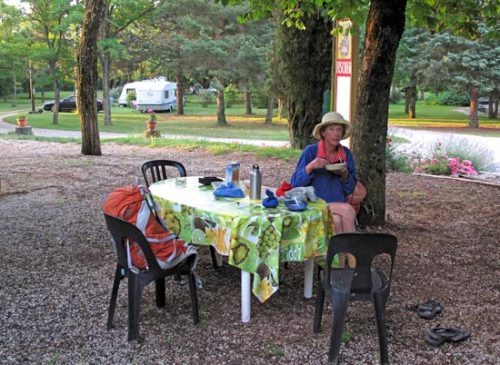
Wednesday, 11 July 2012
Distance 29 km
Duration 6 hours 0 minutes
Ascent 315 m, descent 680 m
Map 162 of the TOP100 lime-green series
We got up at 6:10 am, probably hours earlier than the other campers, but then we have a longstanding fear of walking in the heat.
We went to the deserted bar and had our breakfast of muesli with apricots, then walked the short distance to the village of l’Hospitalet.
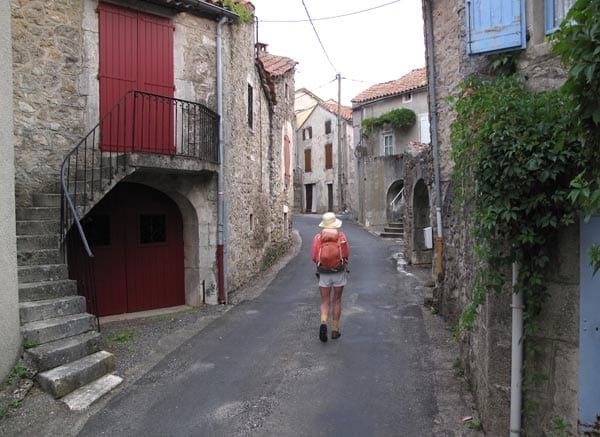
Despite having no shops, it was a charming little place. The autoroute had killed it as far as passing trade was concerned, but saved its life as a pleasant place to live.
Reconnecting with the GR, we set off along a country road flanked by luxuriant crops and almost walked past the turning sign when the GR plunged off to the right, up a steep farm track to the top of the slope, where we entered a wood.
Here the GR joined a little road that took us down the other side towards the A75, which we could see far below.
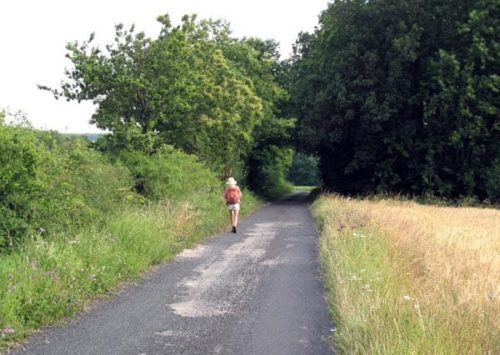
Once down in the fields, we came to an intersection at which all the roads were marked with crosses, except for one going away from the autoroute, which we had no intention of taking.
Instead we pushed on along the road, over another rise, and came to the edge of the mighty A75 with its howling traffic. Here we found a tunnel which led us to an old road and then onto the present highway (the N2009).
From here we could see out over the expanse of the military camp, bare and bleak, with its accommodation blocks lined up at one edge. The village of la Cavalerie was a welcoming cluster of houses and greenery, alone on the high, windswept plain.
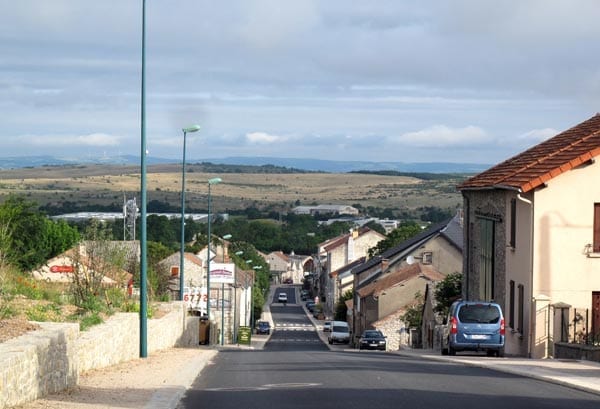
Far away on the horizon stood a line of graceful wind turbines, the twenty-first century’s contribution to the beauty of the French landscape.
Down the main street we came to a boulangerie, at which we bought bread and croissants, and across the road there was a hotel/bar.
The door of the bar was locked so we walked on, but there were no more bars, only a cavernous stone halle, so we doubled back, this time entering through the hotel door.
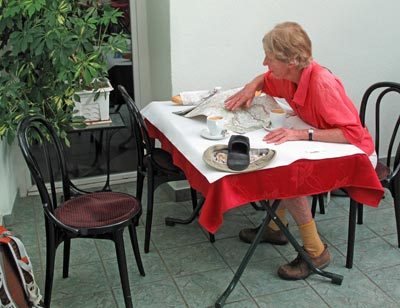
A woman came to the desk and we asked about where we could get coffee. “C’est ici, avancez!”, she declared, showing us into the breakfast room at the back. This had been an open courtyard at some stage but had been roofed with clear plastic, very likely because of the rigorous climate.
A few hotel guests were still there (it was 8:50 am) and we ate our croissants surreptitiously in case it was frowned on. The coffee was large, hot and strong, a great improvement on yesterday’s complete lack of it.
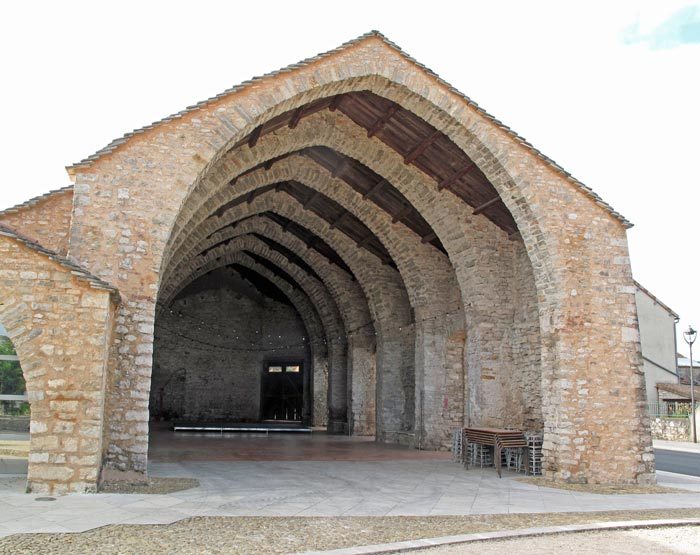
With our water bottles newly filled at the bar, we stepped out on the second leg of our day’s journey.
At the corner near the halle we found GR marks and started to follow them, but soon realised (or thought) that we were heading the wrong way, so we went back and took the road that joined the N9 just north of the town.
According to our map, the GR would cross the road at this junction.
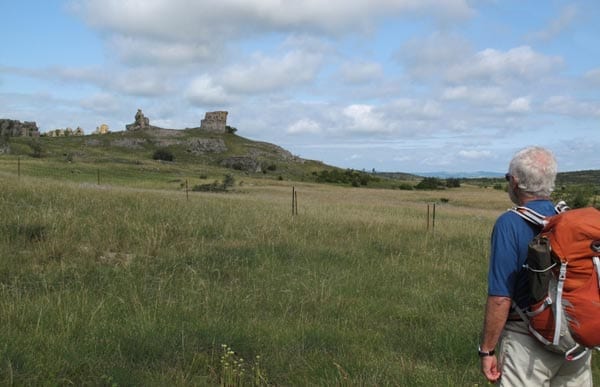
When we got there we could not see a GR mark anywhere (it turned out that the track had been re-routed since our map was made, and now crossed the N9 from the exit road of the autoroute and went beside it on a farm track, invisible from our side, until it veered away across the causse).
Hoping to find the turn-off a bit further on, we started along the N9 but there was nothing for four kilometres, by which time we felt that we would be trudging along the bitumen all the way to Millau.
In the end, in desperation, we took a dusty little unmarked side-road, just to get away from the horrible highway.
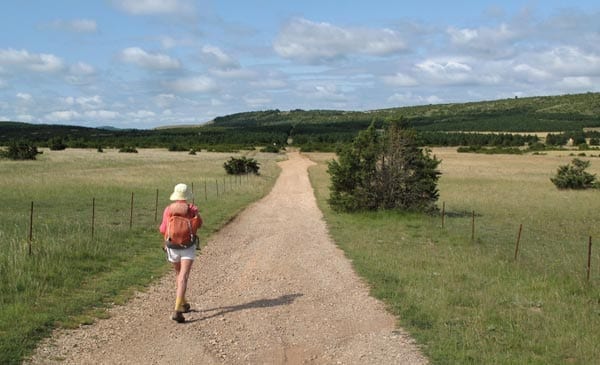
After that it was much better. The landscape was treeless, grassy and slightly undulating, with rocky crowns on the high points.
We thought that we could find our way to the edge of the causse, if need be, even without a track, but the one we were on quickly delivered us back onto the GR, which we were very pleased to see.
At that point there was a curious sight – a plantation of half-grown pines spelling out “1989” if seen from above. These were the “trees of liberty”, planted for the bicentenary of the French Revolution.
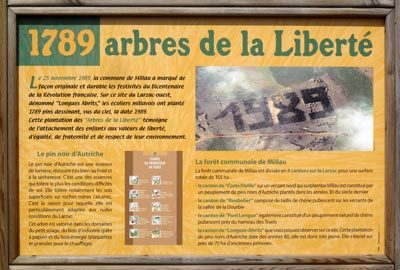
From the ground it was not easy to make out the numbers, but the sign explained it all.
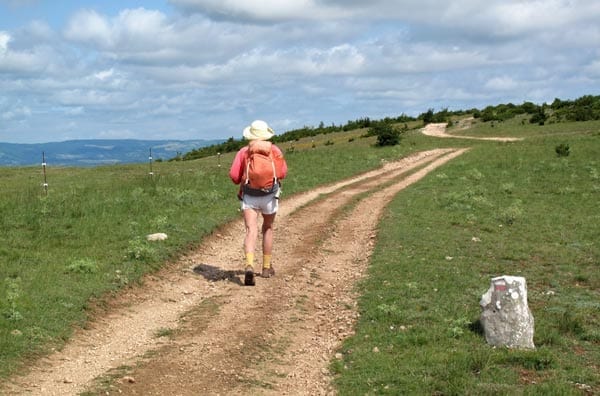
The red dirt wheel track split into a myriad of others, seemingly part of a motocross circuit, but we stuck to the GR marks and eventually climbed to the top of a low hill.
From there we could see the Viaduct of Millau marching away, its slender posts and strands as light as cobwebs shining in the sun. A few lonely farm buildings huddled in a hollow.
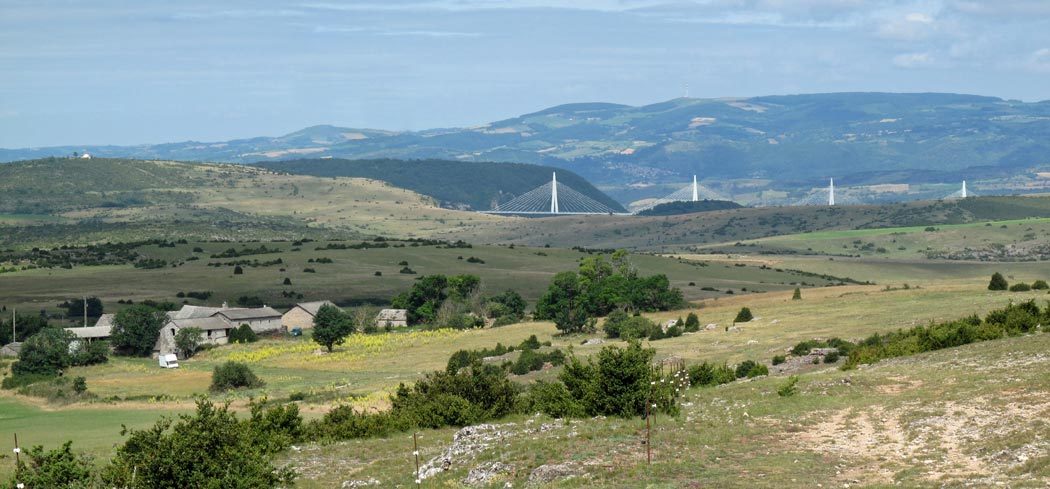
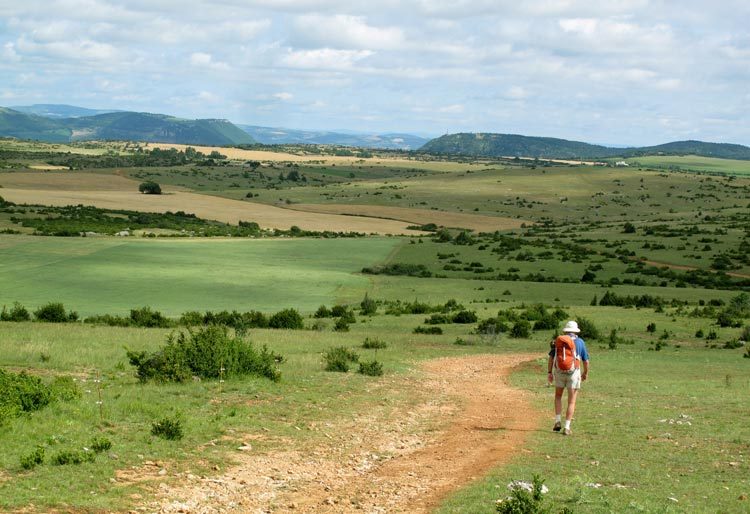
This was where we left the GR, as it was no longer going in our direction, and found our way on a well-defined dirt road going north from the farm.
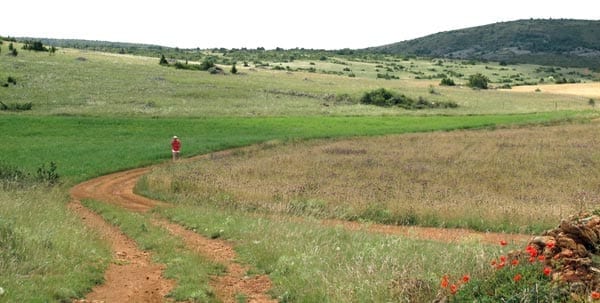
We joined the bitumen just before the tiny hamlet of St-Michel, avoided the road to Creissels and soon afterwards came to the edge of the huge drop into the valley of the Tarn. Millau was spread out below like a pink rash.
The GR appeared again (it had been on a long and no doubt scenic diversion to the west) and we had to choose whether to take it or the road for the descent.
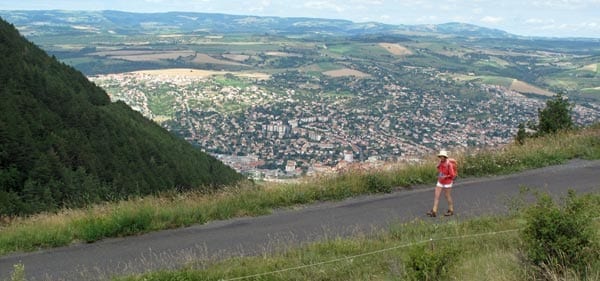
The GR was more direct but much steeper and rougher, down through the pines, and the first part of it was uphill, so we chose the road. Looking back, this was not a good decision.
There were painted marks on the road, presumably for cyclists, starting at 2.2 km and counting down, so we assumed this was the distance to the bottom, but it was not even half-way.
We lost count of the number of hairpin bends we turned. After a long time we passed a few scattered houses, then more and more, and at last we came out onto the great highway sweeping down from the right. Luckily we did not stay beside it for long, as there was an excellent little GR short-cut that took us almost to river level.
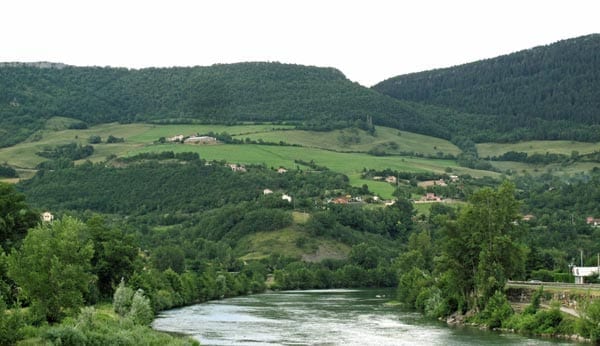
We crossed a bridge and set off for the camping ground, which was over the next bridge to the right.
It was two hours since we had left the top and we still had half an hour’s unpleasant walk on the riverside road. There was a footpath near the water but we found it impossible to get to, which was annoying.
However, all things come to an end, and we eventually arrived at the camping ground where we had stayed on our previous visit to Millau in 2007. It was called the Camping des Deux Rivières, since it was on the confluence of the Tarn with its tributary, the Doubie.
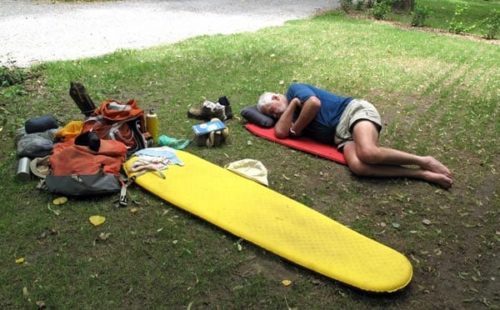
We settled ourselves on a patch of thin young lawn, so young that the lines of its newly-germinated grass were still visible. Overhead, beautiful old poplars cast their dense shade.
We had lunch, although it was after 2 pm, then put up the tent and did our ablutions in the rather cool showers.
In clean clothes, and with our washing strung out along the hedge, we went around to the front of the reception building, where there were bar tables set up, and had our second round of coffee for the day.
Later we strolled into town. It had a much more flourishing air now than it had had five years earlier. The decrepit glove factories and grimy, peeling houses along the entry street had all been done up and the centre had many new shops and bars.
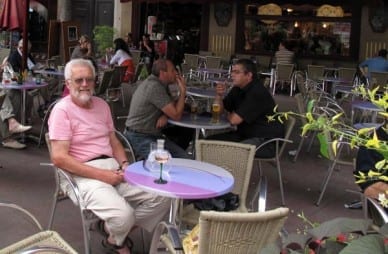
At the roundabout with the grand fountain we saw a sign to the railway station and walked the few blocks to get our tickets for tomorrow. This was the end of our southern walk.
We spent an enjoyable hour wandering through the lanes of the old town, all bright and bustling compared to our last visit, and after apéritifs at a big brasserie near the fountain, we retired to a little restaurant jammed into a corner of a lane, la Pierre Bleue.
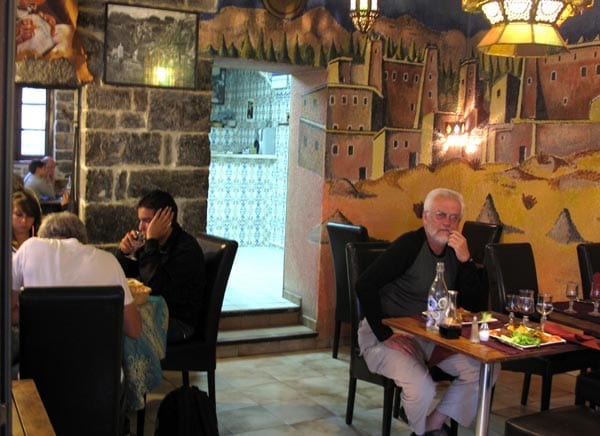
The outdoor tables were full of diners but we preferred indoors, as it was getting cooler by the minute.
The cuisine was Moroccan/French and the walls were covered with fanciful paintings of mud-brick cities in the desert. Having had too great an exposure to Moroccan food in Cavaillon, we chose the French menu, three courses for €16.50. We asked for a half-litre of house wine (a pichet), although it was not offered on the menu.
The first course was a Moroccan salad, similar to a French one except for a slice of orange at the side and the exuberantly decorated plate that it came on.
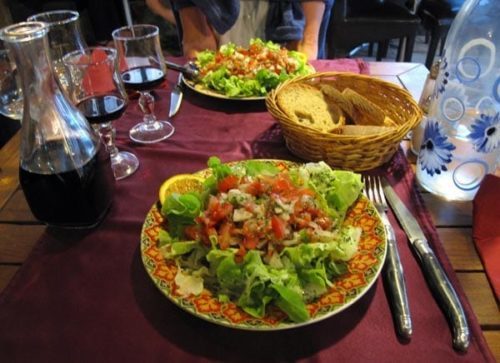
Then we had steaks accompanied by couscous and various vegetables, which we asked for specially instead of chips.
To finish we had apple tart, or rather Keith did, while I requested and got a plate of cheese, which I put away in my faithful plastic bag for tomorrow. All in all, we felt like very fussy customers, but our waiter seemed happy to indulge us.
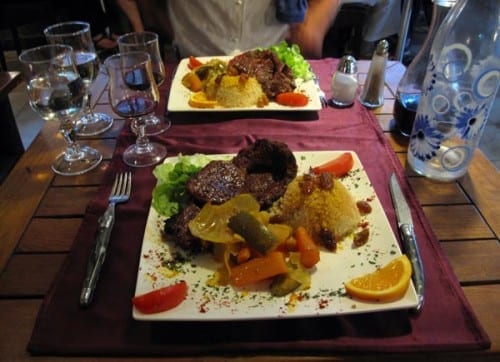
By the time we got back to our tent, almost every emplacement in the camping ground was occupied. Even with the wonderful Viaduct in operation, Millau remains a favourite overnight halt for holiday makers coming from the north to the Mediterranean.
Leaving Millau
Millau has a railway station. From there you can go to almost anywhere in France. Also, from the Millau railway station, there is a SNCFautocar(bus) to Montpellier.